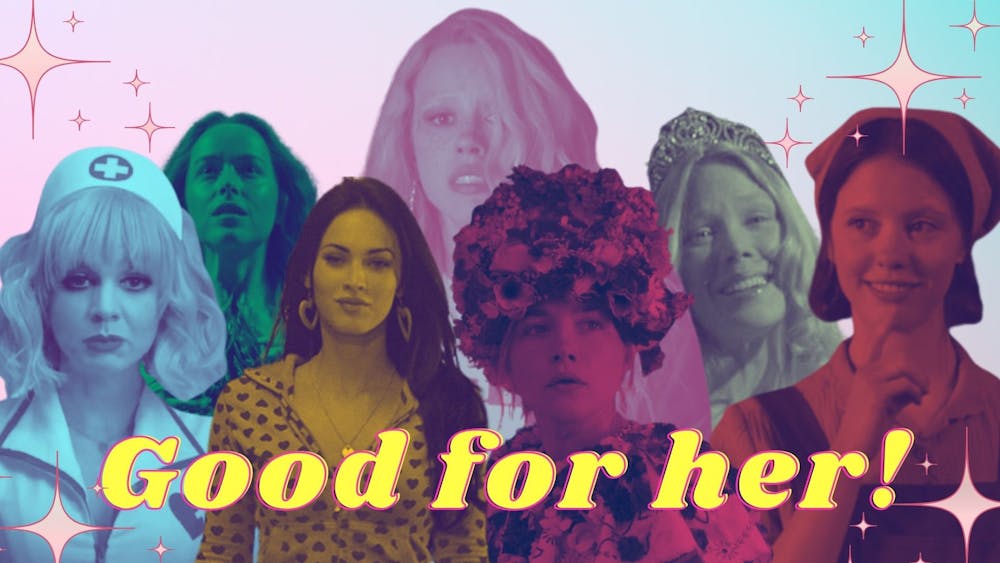There’s nothing I love more than a final girl, or a girl who’s out for revenge.
Characters like this are almost always at the center of my favorite films, which, I’ve learned, fall under a subgenre by a rather fitting name: The “Good for Her Cinematic Universe.”
But why that name? It’s simple, really. Films in the “Good for Her” subgenre follow women who get what they want at any and all costs, usually after experiencing some form of turmoil or trauma.
The GFHCU will be getting another addition this summer with the release of Ti West’s “MaXXXine,” the third installment of his “X” trilogy, on July 5. I am a huge fan of “Pearl” and “X,” both of which are perfect examples of the subgenre, and Maxine Minx is my favorite final girl of all time.
In “Pearl,” Pearl is forcefully isolated and undermined by her mother; she dreams of being a star, but no one believes in her. Eventually, Pearl takes matters into her own hands, leaving a bloody trail behind her.
Maxine Minx, the main character of “X” and “MaXXXine,” is also determined to be a star. Her story parallels Pearl’s in an eerily similar way, but Maxine does what Pearl doesn’t — she succeeds after fighting for her life and fleeing to Los Angeles.
It’s important to understand a large element of the “Good for Her Cinematic Universe” is violence. Usually, the women at the forefront of this genre resort to violence in some way to achieve what they want.
Is this condonable? To answer, I’ll quote an article about the “Good for Her Cinematic Universe” from Vulture: “No. 1 culture theorist of our time Lady Gaga once said, ‘I don’t believe in the glorification of murder; I do believe in the empowerment of women.’”
The “X” universe aside, the motives for many of the womens’ actions in the “Good for Her” subgenre stem from traumatic experiences. By getting vengeance or overcoming a painful situation, these characters are taking back their own lives and empowering themselves.
A great example of this is Dani in “Midsommar.” Her boyfriend, Christian, is insufferable and treats her horribly. By the end of the film, Dani becomes the May Queen of the Hårga cult and chooses Christian to be sacrificed, watching with a cathartic smile as the toxicity in her life is literally set aflame.
Red, a character in Jordan Peele’s “Us,” tries to take back her own life by leading a group of doppelgängers called the Tethered in murdering their counterparts. We don’t understand her motives until the end of the film, when we learn that Red is not a doppelgänger but the original version of herself. After living a hellish life among the Tethered, she wants to repossess the life she once had.
Enjoy what you're reading?
Signup for our newsletter
In Luca Guadagnino’s 2018 remake of “Suspiria,” Susie Bannion arrives at the prestigious Markos Dance Academy, which is run by a corrupt coven of witches.
Susie initially seems to want to become the best dancer, but her intentions are revealed to be much larger: She is the powerful Mother Suspiriorum, and she has come to kill Markos and her followers in order to take back the academy and restore its order.
Other characters in the “Good for Her Cinematic Universe” take back their own autonomy after being sexually assaulted and/or abused. Jennifer Check in “Jennifer’s Body” is brutalized by members of a rock band during a satanic ritual.
After being possessed by a demon, Jennifer begins killing and eating boys in order to survive, and, at the end of the film, her ex-best friend Needy gets vengeance for Jennifer by slaughtering the band that sacrificed her — two “good for her”s in one.
Emerald Fennell’s “Promising Young Woman” follows Cassie Thomas as she seeks justice for her best friend Nina, who committed suicide after being sexually assaulted. Cassie doesn’t kill anyone — in fact, she’s tragically murdered — but she ultimately succeeds in bringing righteouness to Nina and herself.
Some characters in the Good for Her subgenre simply lash out due to being mistreated. Brian De Palma’s 1976 adaptation of Stephen King’s “Carrie” is a classic example.
Carrie White, a girl with telekinetic abilities, is relentlessly bullied at school and abused by her mother. From publicly shaming her for menstruating to being soaked in pig’s blood at prom, Carrie’s peers are determined to make her life miserable. Eventually, Carrie snaps, killing everyone at the prom and then her own mother — all of which had it coming.
The “Good for Her Cinematic Universe” has spanned across generations, but there’s certainly been an influx of films that fall under the subgenre within the last 10 years.
These characters and their stories are important. Not only do they perfectly depict female rage and anguish — they open discussions surrounding justice and empowerment for women.




